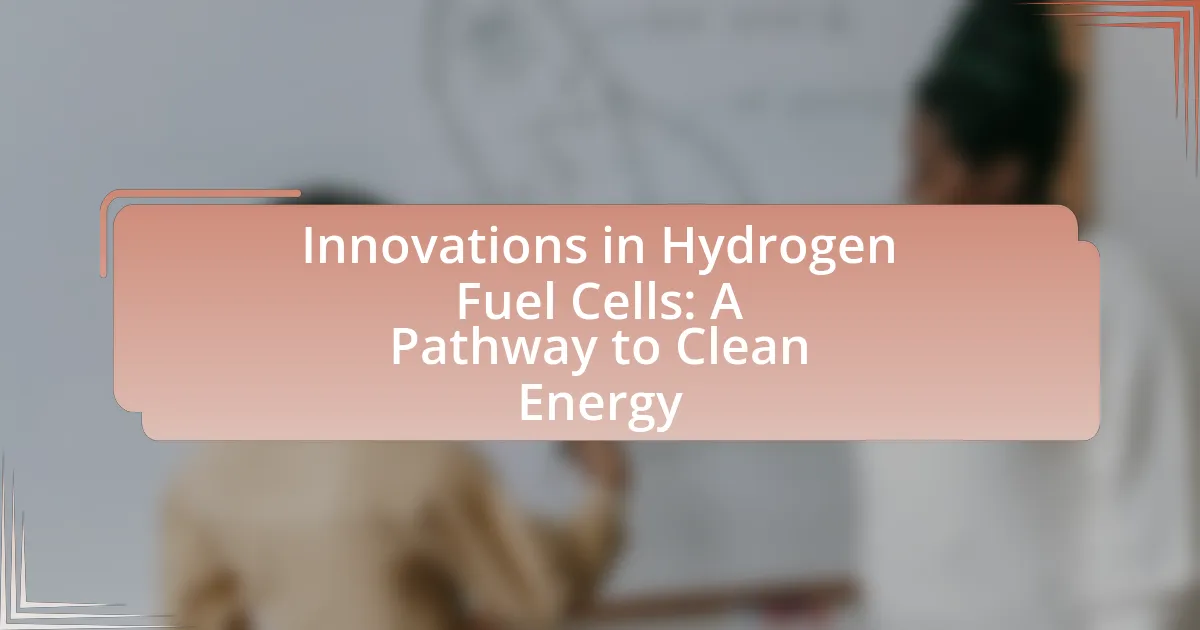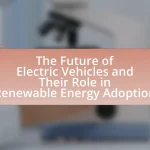Innovations in hydrogen fuel cells represent significant advancements in clean energy technology, focusing on improved materials, efficiency, and production methods. Key developments include the use of cost-effective catalysts, enhanced membrane technology, and optimized system designs that increase performance while reducing costs. Hydrogen fuel cells operate by converting hydrogen and oxygen into electricity, emitting only water vapor as a byproduct, thus contributing to reduced greenhouse gas emissions. The article also addresses the challenges of adoption, including high production costs and limited infrastructure, while highlighting the importance of public perception and regulatory frameworks in shaping the future of hydrogen fuel cells as a viable energy solution.
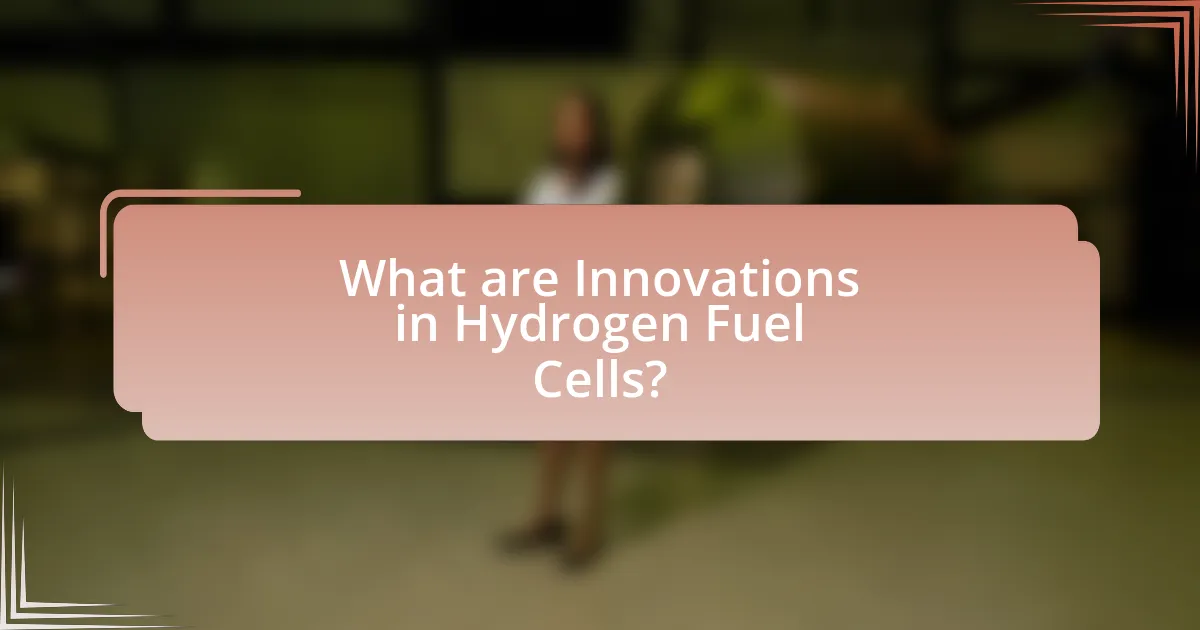
What are Innovations in Hydrogen Fuel Cells?
Innovations in hydrogen fuel cells include advancements in materials, efficiency, and production methods. Recent developments focus on using catalysts made from abundant materials like nickel instead of precious metals, which reduces costs and enhances sustainability. Additionally, researchers are improving the efficiency of fuel cells by optimizing membrane technology, leading to higher power outputs and longer lifespans. For instance, a study published in the journal Nature Energy highlights the use of new polymer membranes that can operate at higher temperatures, increasing overall efficiency. These innovations are crucial for making hydrogen fuel cells a viable alternative for clean energy applications, such as transportation and stationary power generation.
How do hydrogen fuel cells function as a clean energy source?
Hydrogen fuel cells function as a clean energy source by converting chemical energy from hydrogen into electrical energy through an electrochemical reaction. In this process, hydrogen gas is fed into the anode of the fuel cell, where it splits into protons and electrons. The protons pass through a membrane to the cathode, while the electrons travel through an external circuit, generating electricity. At the cathode, oxygen combines with the protons and electrons to produce water and heat as byproducts. This reaction emits no harmful pollutants, making hydrogen fuel cells a sustainable energy solution. According to the U.S. Department of Energy, hydrogen fuel cells can achieve efficiencies of up to 60%, significantly reducing greenhouse gas emissions compared to traditional fossil fuels.
What are the key components of a hydrogen fuel cell?
The key components of a hydrogen fuel cell are the anode, cathode, electrolyte, and external circuit. The anode is where hydrogen gas is supplied and split into protons and electrons. The electrolyte allows only protons to pass through while blocking electrons, which travel through the external circuit to generate electricity. The cathode is where oxygen is introduced, and it combines with the protons and electrons to produce water and heat as byproducts. These components work together to convert chemical energy from hydrogen into electrical energy efficiently, making hydrogen fuel cells a promising technology for clean energy solutions.
How does the electrochemical process work in hydrogen fuel cells?
The electrochemical process in hydrogen fuel cells converts chemical energy from hydrogen and oxygen into electrical energy through a reaction that produces water as a byproduct. In this process, hydrogen gas is supplied to the anode, where it is split into protons and electrons by a catalyst. The protons pass through the electrolyte membrane to the cathode, while the electrons travel through an external circuit, generating electricity. At the cathode, oxygen from the air combines with the protons and electrons to form water. This reaction is efficient, with fuel cells achieving up to 60% efficiency in converting fuel to electricity, significantly higher than traditional combustion engines.
What recent advancements have been made in hydrogen fuel cell technology?
Recent advancements in hydrogen fuel cell technology include the development of more efficient catalysts, improved membrane materials, and enhanced system designs that increase overall performance and reduce costs. For instance, researchers have created platinum-free catalysts that significantly lower the cost of fuel cells while maintaining high efficiency, as demonstrated in studies published in the Journal of Power Sources. Additionally, advancements in proton exchange membrane (PEM) technology have led to membranes that operate effectively at higher temperatures and pressures, which enhances the fuel cell’s power output and durability. These innovations collectively contribute to making hydrogen fuel cells a more viable option for clean energy applications.
What breakthroughs have improved efficiency in hydrogen fuel cells?
Recent breakthroughs that have improved efficiency in hydrogen fuel cells include advancements in catalyst materials, membrane technology, and system integration. For instance, the development of platinum-free catalysts, such as those based on transition metals, has significantly reduced costs while maintaining high activity levels, enhancing overall efficiency. Additionally, innovations in proton exchange membranes, like those made from advanced polymers, have improved ionic conductivity and durability, leading to better performance under various operating conditions. Furthermore, integrated systems that optimize the balance of plant components have streamlined hydrogen fuel cell operations, resulting in higher energy output and lower energy losses. These advancements collectively contribute to the enhanced efficiency of hydrogen fuel cells, making them more viable for widespread adoption in clean energy applications.
How have materials science innovations impacted hydrogen fuel cells?
Materials science innovations have significantly enhanced the performance and efficiency of hydrogen fuel cells. Advances in catalyst materials, such as the development of platinum-free catalysts, have reduced costs and improved the overall efficiency of fuel cells, enabling more widespread adoption. For instance, research published in the journal “Nature” by researchers from Stanford University demonstrated that new alloy catalysts can achieve comparable performance to traditional platinum-based catalysts while using less precious metal, thus lowering production costs. Additionally, innovations in membrane technology, such as the use of proton exchange membranes with improved conductivity and durability, have led to increased power output and longevity of fuel cells. These advancements collectively contribute to making hydrogen fuel cells a more viable option for clean energy solutions.
Why is hydrogen fuel cell technology important for clean energy?
Hydrogen fuel cell technology is important for clean energy because it produces electricity through a chemical reaction between hydrogen and oxygen, emitting only water vapor as a byproduct. This process significantly reduces greenhouse gas emissions compared to fossil fuels, contributing to a cleaner environment. According to the U.S. Department of Energy, hydrogen fuel cells can achieve efficiencies of up to 60%, making them a highly efficient energy source. Additionally, hydrogen can be produced from renewable resources, such as water and biomass, further enhancing its role in sustainable energy systems.
What role do hydrogen fuel cells play in reducing carbon emissions?
Hydrogen fuel cells significantly reduce carbon emissions by converting hydrogen and oxygen into electricity, with water as the only byproduct. This process eliminates the combustion of fossil fuels, which is a primary source of carbon dioxide emissions. According to the U.S. Department of Energy, hydrogen fuel cells can achieve efficiencies of up to 60%, compared to traditional combustion engines that typically operate at around 20-30% efficiency, thereby minimizing energy waste and associated emissions. Furthermore, when hydrogen is produced from renewable sources, such as wind or solar power, the overall carbon footprint is drastically lowered, contributing to a cleaner energy landscape.
How can hydrogen fuel cells contribute to energy security?
Hydrogen fuel cells can significantly enhance energy security by providing a reliable and versatile energy source that reduces dependence on fossil fuels. They generate electricity through a chemical reaction between hydrogen and oxygen, producing only water as a byproduct, which contributes to environmental sustainability. The use of hydrogen fuel cells can diversify the energy mix, allowing countries to utilize domestically produced hydrogen from various sources, including renewable energy, natural gas, and biomass. This diversification mitigates risks associated with energy supply disruptions and price volatility in global oil and gas markets. Furthermore, hydrogen fuel cells can support grid stability and resilience by acting as energy storage systems, enabling the integration of intermittent renewable energy sources like wind and solar. According to the International Energy Agency, hydrogen could account for up to 18% of global energy demand by 2050, underscoring its potential role in enhancing energy security.
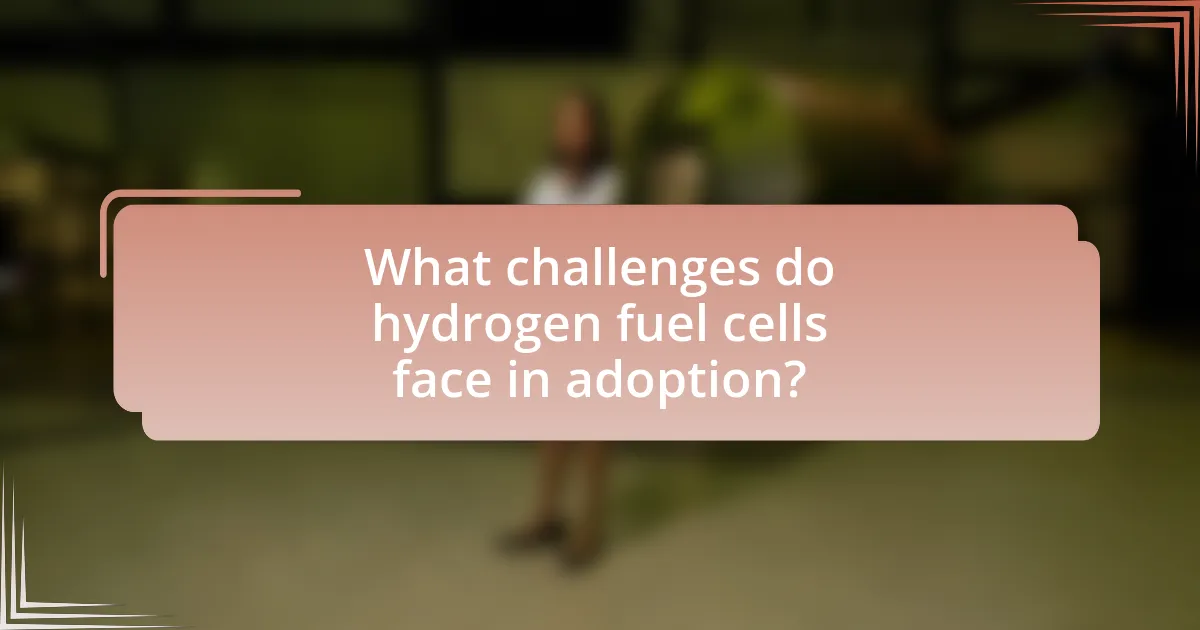
What challenges do hydrogen fuel cells face in adoption?
Hydrogen fuel cells face significant challenges in adoption, primarily due to high production costs, limited infrastructure, and safety concerns. The production of hydrogen, especially through methods like electrolysis, remains expensive, with costs around $5 to $6 per kilogram, making it less competitive compared to fossil fuels. Additionally, the lack of widespread refueling infrastructure limits the practicality of hydrogen vehicles, as only a few hundred hydrogen stations exist globally, primarily in regions like California and Japan. Safety concerns also hinder adoption, as hydrogen is highly flammable and requires stringent safety measures during storage and transport. These factors collectively impede the broader implementation of hydrogen fuel cells in the energy market.
What are the economic barriers to widespread hydrogen fuel cell use?
The economic barriers to widespread hydrogen fuel cell use include high production costs, limited infrastructure, and competition from established energy sources. Hydrogen production, particularly through methods like electrolysis, can be expensive, with costs ranging from $4 to $6 per kilogram, making it less competitive compared to fossil fuels. Additionally, the lack of refueling infrastructure limits consumer adoption, as only a few hundred hydrogen stations exist globally, primarily in regions like California and Japan. Furthermore, established energy sources, such as natural gas and electricity, often have lower costs and more developed supply chains, making it challenging for hydrogen fuel cells to gain market share.
How do production and infrastructure costs affect hydrogen fuel cell deployment?
Production and infrastructure costs significantly impact hydrogen fuel cell deployment by influencing the overall economic feasibility and scalability of hydrogen technologies. High production costs, primarily due to the energy-intensive processes required for hydrogen extraction and purification, can deter investment and slow market adoption. For instance, as of 2023, the cost of producing green hydrogen through electrolysis remains around $4 to $6 per kilogram, which is substantially higher than fossil fuel alternatives.
Additionally, infrastructure costs, including the development of hydrogen refueling stations and distribution networks, further complicate deployment. The current lack of widespread infrastructure limits accessibility for consumers and businesses, creating a chicken-and-egg scenario where low demand leads to insufficient investment in infrastructure, which in turn hampers demand. According to the Hydrogen Council, an estimated $300 billion investment is needed by 2030 to establish a robust hydrogen infrastructure to support fuel cell vehicles.
Thus, both production and infrastructure costs are critical barriers that must be addressed to enable the broader adoption of hydrogen fuel cells as a viable clean energy solution.
What are the regulatory challenges surrounding hydrogen fuel cells?
Regulatory challenges surrounding hydrogen fuel cells include safety standards, infrastructure development, and environmental regulations. Safety standards are critical due to the flammability of hydrogen, necessitating stringent guidelines for production, storage, and transportation. Infrastructure development poses challenges as existing fueling stations are limited, requiring significant investment and coordination among stakeholders to expand networks. Environmental regulations must also be navigated, as hydrogen production methods vary in their carbon footprint, influencing compliance with emissions standards. These challenges hinder the widespread adoption of hydrogen fuel cells, as evidenced by the slow rollout of hydrogen infrastructure in regions like Europe and North America, where regulatory frameworks are still evolving.
How can public perception influence the adoption of hydrogen fuel cells?
Public perception significantly influences the adoption of hydrogen fuel cells by shaping consumer acceptance and policy support. Positive public perception can lead to increased demand for hydrogen fuel cell vehicles, as seen in surveys indicating that consumer interest in clean energy solutions drives market growth. For instance, a 2021 study by the International Energy Agency found that public awareness and favorable attitudes towards hydrogen technologies correlate with higher investment in infrastructure and research. Conversely, negative perceptions, often stemming from safety concerns or lack of understanding, can hinder adoption, as evidenced by the slow uptake in regions where public skepticism prevails. Thus, fostering a positive public image through education and outreach is crucial for accelerating the transition to hydrogen fuel cells.
What misconceptions exist about hydrogen fuel cells?
Misconceptions about hydrogen fuel cells include the belief that they are inefficient and that hydrogen production is always environmentally harmful. In reality, hydrogen fuel cells convert chemical energy directly into electrical energy with efficiencies often exceeding 60%, which is higher than traditional combustion engines. Additionally, hydrogen can be produced through renewable methods, such as electrolysis powered by solar or wind energy, making it a clean energy source. According to the U.S. Department of Energy, when produced from renewable resources, hydrogen can significantly reduce greenhouse gas emissions, countering the misconception that its production is inherently polluting.
How can education and outreach improve public understanding of hydrogen technology?
Education and outreach can significantly improve public understanding of hydrogen technology by providing clear, accessible information and engaging communities in discussions about its benefits and applications. Effective educational programs can demystify hydrogen technology, illustrating its role in clean energy solutions, such as reducing greenhouse gas emissions and enhancing energy security. For instance, initiatives like workshops, webinars, and informational campaigns can present data showing that hydrogen fuel cells emit only water vapor, making them a clean alternative to fossil fuels. Furthermore, outreach efforts can involve partnerships with local organizations to foster trust and encourage public participation, ultimately leading to greater acceptance and support for hydrogen initiatives.
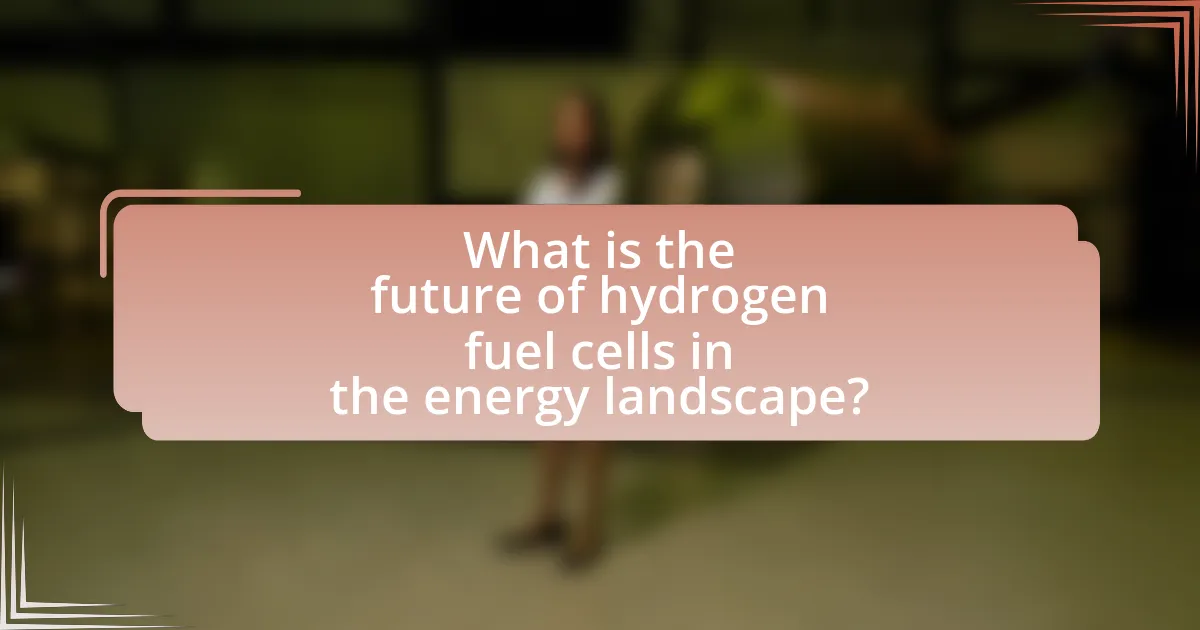
What is the future of hydrogen fuel cells in the energy landscape?
The future of hydrogen fuel cells in the energy landscape is promising, as they are increasingly recognized for their potential to provide clean, efficient energy solutions. Hydrogen fuel cells produce electricity through a chemical reaction between hydrogen and oxygen, emitting only water vapor as a byproduct, which aligns with global goals for reducing carbon emissions. According to the International Energy Agency, the hydrogen economy could contribute up to 20% of global energy needs by 2050, driven by advancements in technology and decreasing production costs. Furthermore, major automotive manufacturers are investing heavily in hydrogen fuel cell technology, with companies like Toyota and Hyundai leading the way in developing fuel cell vehicles, indicating a strong market shift towards hydrogen as a viable alternative to fossil fuels.
How are governments and industries investing in hydrogen fuel cell technology?
Governments and industries are investing in hydrogen fuel cell technology through substantial funding, research initiatives, and infrastructure development. For instance, the European Union has allocated over €430 billion for hydrogen-related projects as part of its Green Deal, aiming to boost clean energy transition. Additionally, countries like Japan and South Korea have committed billions to support hydrogen infrastructure, including production facilities and refueling stations. Major corporations, such as Toyota and Hyundai, are also investing heavily in hydrogen fuel cell vehicles, with Toyota planning to invest $13.6 billion in hydrogen technology by 2030. These investments are aimed at reducing carbon emissions and promoting sustainable energy solutions.
What initiatives are being launched to promote hydrogen fuel cell research?
Governments and private organizations are launching several initiatives to promote hydrogen fuel cell research. For instance, the U.S. Department of Energy has introduced the Hydrogen Program, which allocates funding for research and development projects aimed at advancing hydrogen technologies, including fuel cells. Additionally, the European Union’s Hydrogen Strategy aims to invest €430 billion by 2030 to scale up hydrogen production and infrastructure, thereby enhancing research efforts in this field. These initiatives are supported by various partnerships between industry leaders and academic institutions, fostering innovation and collaboration in hydrogen fuel cell technology.
How are partnerships between sectors shaping the future of hydrogen fuel cells?
Partnerships between sectors are accelerating the development and deployment of hydrogen fuel cells by combining resources, expertise, and technology. For instance, collaborations between automotive manufacturers and energy companies are leading to advancements in fuel cell technology, as seen in projects like the Hydrogen Council, which includes major players such as Toyota and Shell. These partnerships facilitate shared investments in research and infrastructure, enabling the scaling of hydrogen production and distribution networks. Additionally, joint ventures between technology firms and government entities are fostering innovation in hydrogen storage and efficiency, exemplified by initiatives funded by the U.S. Department of Energy that aim to reduce costs and improve performance. Such cross-sector collaborations are essential for overcoming technical and economic barriers, ultimately shaping a sustainable future for hydrogen fuel cells in the clean energy landscape.
What practical applications are emerging for hydrogen fuel cells?
Emerging practical applications for hydrogen fuel cells include transportation, stationary power generation, and industrial processes. In transportation, hydrogen fuel cells are being utilized in vehicles such as buses, trucks, and trains, offering a zero-emission alternative to fossil fuels. For stationary power generation, hydrogen fuel cells provide reliable energy for buildings and remote locations, enhancing energy security and reducing reliance on traditional power sources. In industrial processes, hydrogen fuel cells are increasingly used for high-temperature applications, such as steel manufacturing, where they can replace carbon-intensive methods. These applications are supported by advancements in hydrogen production and storage technologies, making hydrogen a viable option for a sustainable energy future.
How are hydrogen fuel cells being utilized in transportation?
Hydrogen fuel cells are being utilized in transportation primarily to power vehicles, including cars, buses, trucks, and trains, by converting hydrogen gas into electricity. This technology enables zero-emission transportation, as the only byproduct of the reaction is water vapor. For instance, companies like Toyota and Hyundai have developed hydrogen fuel cell vehicles, such as the Toyota Mirai and Hyundai Nexo, which demonstrate the viability of this technology in everyday use. Additionally, hydrogen fuel cell buses are being deployed in various cities worldwide, contributing to cleaner public transportation systems. According to the U.S. Department of Energy, hydrogen fuel cell vehicles can achieve a range comparable to traditional gasoline vehicles, with refueling times similar to those of conventional fuels, making them a practical alternative in the transportation sector.
What role do hydrogen fuel cells play in stationary power generation?
Hydrogen fuel cells serve as a clean and efficient technology for stationary power generation by converting hydrogen and oxygen into electricity, with water as the only byproduct. This process allows for the generation of reliable power for various applications, including residential, commercial, and industrial settings. According to the U.S. Department of Energy, hydrogen fuel cells can achieve efficiencies of up to 60%, significantly higher than traditional combustion-based power generation methods. Additionally, they can operate continuously, providing a stable energy supply, which is crucial for grid stability and energy resilience.
What best practices should be followed for implementing hydrogen fuel cells?
Best practices for implementing hydrogen fuel cells include ensuring safety protocols, optimizing system design, and integrating renewable hydrogen production. Safety protocols are crucial due to the flammability of hydrogen; for instance, adhering to guidelines from organizations like the National Fire Protection Association can mitigate risks. Optimizing system design involves selecting appropriate materials and components to enhance efficiency and durability, as evidenced by advancements in membrane technology that improve performance. Integrating renewable hydrogen production, such as electrolysis powered by solar or wind energy, supports sustainability and reduces carbon emissions, aligning with global clean energy goals.
